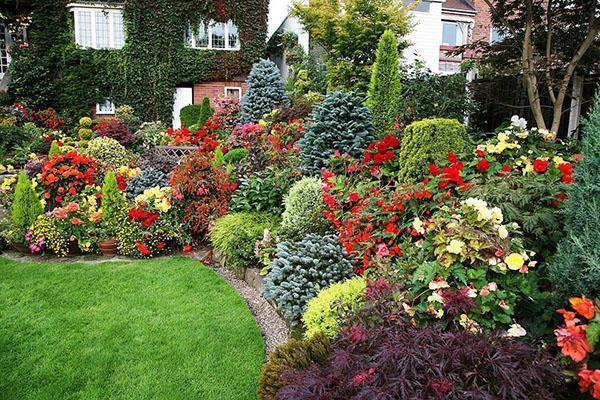English flower garden - a magnificent view in the garden all year round
 The English flower garden is an indispensable place for relaxation. Despite the season, it pleases the eye with its bright palette of colors. This is a kind of walking area, which consists of various flower beds. The main feature of the created front garden is that flowering gradually replaces each other. So, in a season not even one day will pass without anything blooming on it.
The English flower garden is an indispensable place for relaxation. Despite the season, it pleases the eye with its bright palette of colors. This is a kind of walking area, which consists of various flower beds. The main feature of the created front garden is that flowering gradually replaces each other. So, in a season not even one day will pass without anything blooming on it.
In order to implement the conceived project, it is important not only to love plants, but also to know their nature. They have a number of requirements for lighting, soil moisture and microclimate. If you ignore them, the culture will look sickly.
English flower garden at the design stage
The challenge for the gardener is to create the illusion of a double border. The right and left parts of the garden should have a similar structure, but with some differences. As a result, they are connected together, thereby making a mesmerizing impression. Simple principles will help to bring the fairy tale to life. When designing an amazing landscape structure, it is important to:
- Plan a bloom calendar. In this case, it is worth picking up a collection of major crops, and then complementing them with others.
- Select exhibits based on their height. There are varieties that resemble a cloud, others are a weighty bun, and others are a Persian carpet. At the same time, giant specimens serve as the backdrop for miniature ones.
- Combine shades, taking into account the nuances of color. English flower beds with a contrasting effect look pompous. For example, lilac asters are specially combined with yellow chrysanthemums.
- Start from the structure of plants. Some successfully keep their shape, while others appear as spreading / scattered bushes.
Now it is worth placing them correctly in the flowerbed, taking into account the planting rates. On 1m², from 3 (large, tall, like a mountaineer) to 7 (bush, aster-type) exhibits of the same type are planted. From these bright spots, groups are formed, which must be repeated in neighboring flower beds to create a composition of unity.
It is better to use perennials for such combinations. To preserve their decorative effect, crops are transplanted every 3 years by dividing the bush. Also, do not forget about weeding, pruning and feeding.
The assortment of plants is a great thing
It is recommended to plan such a flower garden in advance, otherwise the gardener will start to panic when buying varieties. So, on a piece of paper, they depict a general picture of the garden. In the supermarket, the list of colors is adjusted taking into account the offered assortment. Experienced landscape designers recommend the following varieties that have never been bred. These include:
- Liatris... Low flower stalks feel comfortable in the border area.
- Peonies. They shed their terry buds in June.
- Ciliated loam... Will create a purple cloud in the center of the front garden.
- Gelenium. Produces the effect of the sun on an autumn flower bed.
- Phlox. Known for their cool shades.
- Highlander spread out. Has a voluminous spherical bush.
In a company with daffodils, it is advised to plant Camassia, as well as Astrantia, which will later hide the wilted leaves of these crops. Crocuses are placed on the other side of the English flower garden. The bulbs of these plants do not need to be replanted every year. Among other things, the slopes of the site are strengthened with trees, at the foot of which shrubs are placed, and herbaceous crops will slide from them. In this situation, you can create a pacifying alley of relaxation.